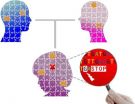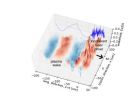(Press-News.org) This news release is available in French.
Research presented by Morris Moscovitch, from the Rotman Research Institute at the University of Toronto, shows that memory is more dynamic and changeable than previously thought. Dr. Moscovich's results reveal that important interactions between the hippocampus and the neocortex, two regions of the brain, have different yet complementary roles in remembering places and events. These results highlight that different forms of memories exist in the brain, and that these are encoded in different, but interacting parts of the brain. Dr. Moscovitch proposes a novel theory to explain these interactions, that furthers our understanding of what we remember, and could be useful for treatment and management of people with memory disorders. These results were presented at the 8th Annual Meeting of the Canadian Association for Neuroscience held in Montreal, Canada May 25 to 28th 2014.
By studying how humans remember events and places in the short and long term, and how rodents remember and navigate through familiar and unfamiliar environment, Dr. Moscovitch and others have revealed differences between what they call "episodic memory", which is a form of memory rich in contextual details, dependent on a brain region called the hippocampus, and another form of memory, called "semantic memory" which relies primarily on neocortex, and which is a more general memory, recording the gist of the initial episodic memory.
Studies in animals and humans have shown that the hippocampus, a brain region located deep inside the brain, has a central role in recent and remote episodic memory. Patients with hippocampal loss, including the famous Henry Molaison (patient HM) and Kent Cochrane (patient KC), were shown to be unable to make new memories, but they retained the ability to recall earlier events, in a schematic, general fashion. Dr. Moscovitch, investigating how rich, recent memories are often converted to more schematic, remote memories has elaborated a theory he has termed "multiple trace/transformation theory".
According to multiple trace/transformation theory, each time an episodic memory is retrieved, it is automatically re-encoded by the hippocampus along with the new context in which retrieval occurs. Over time, and with every retrieval, multiple memory traces accumulate; the neocortex extracts similarities from these traces to form a generalized memory, the semantic memory. By this process, the memory is transformed over time, from a mostly hippocampus dependent, context-rich memory, to a more general memory, a recording of the essential elements of the memory, that captures the gist of the initial episodic memory.
Dr. Moscovitch presented results that show that the same processes apply to memory about places and the environment. Initially dependent on the hippocampus, they also are transformed, and become schematic memories that can be retrieved without the involvement of the hippocampus. As it was previously thought that the hippocampus was always involved in remembering places, this discovery sheds new light on the different forms of memory that exist.
"Spatial representations provide the framework in which events unfold, so that they interact with each other to form rich episodic memories that have both spatial and event elements" says Dr. Moscovitch. "Memory for events is facilitated if they occur in familiar rather than unfamiliar places. These findings could be used to help ameliorate memory problems in older adults, and in people with dementia, who have to leave their home and move into new living quarters."
INFORMATION:
About the Canadian Association for Neuroscience:
The Canadian Association for Neuroscience is the largest association dedicated to the promotion of all fields of neuroscience research in Canada. The association has been organizing a yearly annual meeting since 2007. Learn more about our meeting at: http://www.can-acn.org/meeting2014
New research shows memory is a dynamic and interactive process
Results could be used to help ameliorate memory problems in older adults
2014-05-28
ELSE PRESS RELEASES FROM THIS DATE:
Uncovering clues to the genetic cause of schizophrenia
2014-05-28
NEW YORK, NY (May 21, 2014) — The overall number and nature of mutations—rather than the presence of any single mutation—influences an individual's risk of developing schizophrenia, as well as its severity, according to a discovery by Columbia University Medical Center researchers published in the latest issue of Neuron. The findings could have important implications for the early detection and treatment of schizophrenia.
Maria Karayiorgou, MD, professor of psychiatry and Joseph Gogos, MD, PhD, professor of physiology and cellular biophysics and of neuroscience, and their ...
A path toward more powerful tabletop accelerators
2014-05-28
Making a tabletop particle accelerator just got easier. A new study shows that certain requirements for the lasers used in an emerging type of small-area particle accelerator can be significantly relaxed. Researchers hope the finding could bring about a new era of accelerators that would need just a few meters to bring particles to great speeds, rather than the many kilometers required of traditional accelerators. The research, from scientists at the U.S. Department of Energy's (DOE) Lawrence Berkeley National Laboratory (Berkeley Lab), is presented as the cover story in ...
PTSD treatment cost-effective when patients given choice
2014-05-28
A cost-analysis of post-traumatic stress disorder treatments shows that letting patients choose their course of treatment – either psychotherapy or medication – is less expensive than assigning a treatment and provides a higher quality of life for patients.
In a recent study, published in the Journal of Clinical Psychiatry, PTSD patients allowed to choose between therapies ended up costing about $1,622 less on average per patient per year compared with patients who were assigned treatment. Among patients not given a choice, treatment with prolonged exposure psychotherapy ...
Technology marketers should take consumer life-cycle into account: New Rotman study
2014-05-28
Toronto – If you want grandpa to start using the bank machine instead of standing in line for the teller, the best way to do it is to tell him to "Act now!" with a limited time offer for a banking card, shows new research.
A new study from the University of Toronto's Rotman School of Management suggests marketers should pay attention to where consumers are in their lifecycles when determining how to get them to adopt new technologies.
Marketers may have incorrectly assumed that older consumers avoid products such as debit or credit cards because they are technophobic ...
Supersonic spray delivers high quality graphene layer
2014-05-28
A simple, inexpensive spray method that deposits a graphene film can heal manufacturing defects and produce a high quality graphene layer on a range of substrates, report researchers at the University of Illinois at Chicago and Korea University.
Their study is available online in the journal Advanced Functional Materials.
Graphene, a two-dimensional wonder-material composed of a single layer of carbon atoms, is strong, transparent, and an excellent conductor of electricity. It has potential in a wide range of applications, such as reinforcing and lending electrical ...
NASA sees northern Indian Ocean System 92B's end
2014-05-28
The tropical low pressure area known as System 92B finally dissipated on the east central coast of India on May 27 after six days of struggling to develop. System 92B developed in the Bay of Bengal, Northern Indian Ocean basin on May 21. NASA's TRMM, Aqua and Suomi NPP satellites captured data on the low throughout the ups and downs it experienced until wind shear finally took its toll on the system.
NASA and the Japan Aerospace Exploration Agency's Tropical Rainfall Measuring Mission (TRMM) satellite passed over System 92B on May 19 and 20 and captured data on System ...
Lethal injection comes under new scrutiny after botched execution
2014-05-28
The botched execution in April of a man convicted of murder brought to the fore of national consciousness the precarious state of capital punishment. An article in Chemical & Engineering News (C&EN), the weekly news magazine of the American Chemical Society, details the history of lethal injection, what went wrong in April and how states are currently handling the practice, once deemed the most humane way to execute prisoners.
Jyllian Kemsley, a senior editor at C&EN, explains that the three-compound procedure prison officials use to carry out executions by lethal injection ...
Brazilian researchers find human menstrual blood-derived cells 'feed' embryonic stem cells
2014-05-28
Tampa, Fla. (May 28, 2014) – To be suitable for medical transplantation, one idea is that human embryonic stem cells (hESCs) need to remain "undifferentiated" i.e. they are not changing into other cell types. In determining the best way to culture hESCs so that they remain undifferentiated and also grow, proliferate and survive, researchers have used blood cell "feeder-layer" cultures using animal-derived feeder cells, often from mice (mouse embryonic fibroblasts [MEFs]). This approach has, however, been associated with a variety of contamination problems, including pathogen ...
Can Tai Chi slow the aging process?
2014-05-28
Putnam Valley, NY. (May 28, 2014) – Tai Chi, a traditional Chinese martial art and sport, has been found to be beneficial in raising the numbers of an important type of cell when three groups of young people were tested to discover the benefits of Tai Chi, brisk walking or no exercise. The group performing Tai Chi saw a rise in their cluster of differentiation 34 expressing (CD34+) cells, a stem cell important to a number of the body's functions and structures.
The study was published in issue 23(4/5) of Cell Transplantation and is freely available on-line at: http://www.ingentaconnect.com/content/cog/ct/2014/00000023/F0020004/art00020.
"To ...
Scientists control rapid re-wiring of brain circuits using patterned visual stimulation
2014-05-28
In a new study, published in this week's issue of the journal Science, researchers show for the first time how the brain re-wires and fine-tunes its connections differently depending on the relative timing of sensory stimuli. In most neuroscience textbooks today, there is a widely held model that explains how nerve circuits might refine their connectivity based on patterned firing of brain cells, but it has not previously been directly observed in real time. This "Hebbian Theory", named after the McGill University psychologist Donald Olding Hebb who first proposed it in ...
LAST 30 PRESS RELEASES:
iPS cells from dish to freezer and back
Deep neural networks enable accurate pricing of American options under stochastic volatility
Collective risk resonance in Chinese stock sectors uncovered through higher-order network analysis
Does CPU impact systemic risk contributions of Chinese sectors? Evidence from mixed frequency methods with asymmetric tail long memory
General intelligence framework to predict virus adaptation based on a genome language model
Antibiotic resistance is ancient, ecological, and deeply connected to human activity, new review shows
Vapes, pouches, heated tobacco, shisha, cigarettes: nicotine in all forms is toxic to the heart and blood vessels
From powder to planet: University of Modena engineers forge a low-carbon future for advanced metal manufacturing
Super strain-resistant superconductors
Pre-school health programme does not improve children’s diet or physical activity, prompting call for policy changes, study finds
Autumn clock change linked to reduction in certain health conditions
AI images of doctors can exaggerate and reinforce existing stereotypes
Where medicine meets melody – how lullabies help babies and parents in intensive care
We may never be able to tell if AI becomes conscious, argues philosopher
AI video translation shows promise but humans still hold the edge
Deep ocean earthquakes drive Southern Ocean’s massive phytoplankton blooms, study finds
Without campus leftovers to pick through, the beaks of this bird changed shape during the pandemic
High-dose antibiotic does not reduce mortality in tuberculous meningitis
How many insects fly in the sky above the USA?
Could cheese protect your brain health?
Who faces more difficulty recovering from stroke?
Colliding galaxies create the brightest, fastest growing black holes at their center
New BrainHealth research reveals tradeoffs on sleep with cannabis use for chronic pain
Aging-US now on ResearchGate, enhancing visibility for authors and readers
'Molecular glue' stabilizes protein that inhibits development of non-small cell lung cancer
Mount Sinai Health System is recognized in 2025 Chime Digital Health Most Wired survey
From prey to predator: How carnivores spread beneficial fungi
Menopause symptoms may be frequent and have negative effects, according to female endurance athletes
US Congressmembers’ responses on X to mass shooting events differ along party lines
KAIST-UEL team develops “origami” airless wheel to explore lunar caves
[Press-News.org] New research shows memory is a dynamic and interactive processResults could be used to help ameliorate memory problems in older adults




